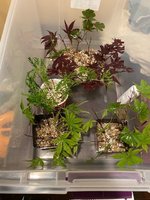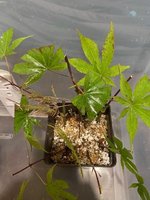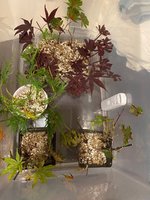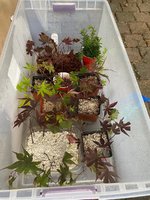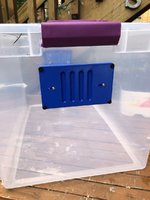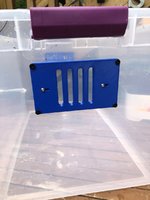Blue Star
Seedling
Hi, I'm relatively new to propagating maple cuttings and need some more experienced advice.
My Japanese maple cuttings last summer dried out while under the deck. Even after misting half a dozen times a day, the high heat, humidity, and wind won.
This year I tried a clear tote propagation box, hedging my odds with one tote inside and one tote outside under the deck.
The green cuttings (I believe Arakawa) indoor developed brown spots (not dried out and crispy though) on July 10th and by July 18th they were shriveling up. The same cuttings in the outdoor tote were fine. All collected from same tree on same day, all equipment cleaned and sterilized. The red cuttings (I believe Bloodgood) indoor faired better, but not great. Does anyone have an idea of what went wrong? I'm assuming I misted too much and developed rot in the leaves, but welcome other input.
Inside conditions: 21 - 23*C/ 70 - 74* F, under LED pot lights, misting 2x per day.
Outside conditions: 15 - 32*C/ 60 - 89*F, no direct light, misting 2x per day.
Both have temp/humid sensors, humidity is pretty stable at 95% RH. Lids are closed with no air holes, so I open them up for 20 min per day and re-mist.
Growing media is a mix of perlite, sphagnum moss, and coconut coir, in various ratios.
Attached are photos of the indoor tote on July 10th, July 18th, and the outdoor tote on July 18th.
Thanks!
My Japanese maple cuttings last summer dried out while under the deck. Even after misting half a dozen times a day, the high heat, humidity, and wind won.
This year I tried a clear tote propagation box, hedging my odds with one tote inside and one tote outside under the deck.
The green cuttings (I believe Arakawa) indoor developed brown spots (not dried out and crispy though) on July 10th and by July 18th they were shriveling up. The same cuttings in the outdoor tote were fine. All collected from same tree on same day, all equipment cleaned and sterilized. The red cuttings (I believe Bloodgood) indoor faired better, but not great. Does anyone have an idea of what went wrong? I'm assuming I misted too much and developed rot in the leaves, but welcome other input.
Inside conditions: 21 - 23*C/ 70 - 74* F, under LED pot lights, misting 2x per day.
Outside conditions: 15 - 32*C/ 60 - 89*F, no direct light, misting 2x per day.
Both have temp/humid sensors, humidity is pretty stable at 95% RH. Lids are closed with no air holes, so I open them up for 20 min per day and re-mist.
Growing media is a mix of perlite, sphagnum moss, and coconut coir, in various ratios.
Attached are photos of the indoor tote on July 10th, July 18th, and the outdoor tote on July 18th.
Thanks!

